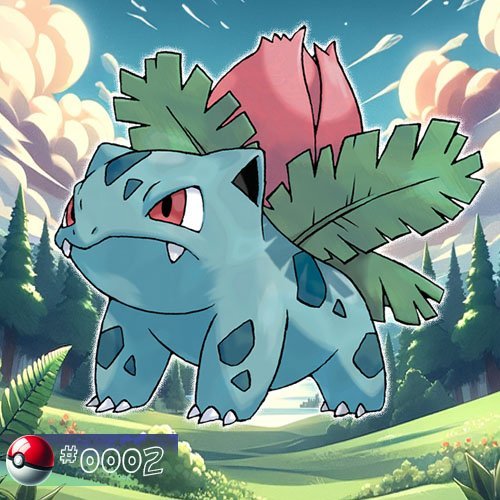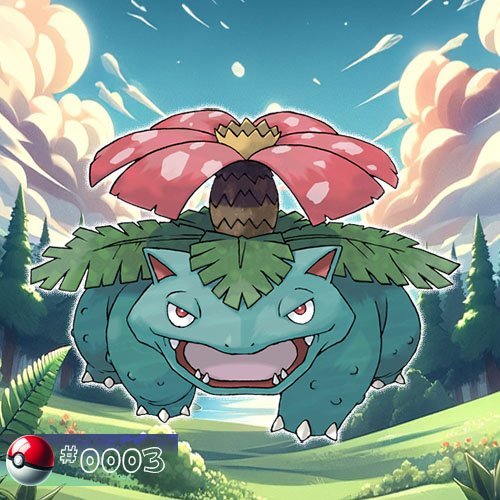Bulbasaur
Bulbasaur is one of the original and iconic Pokémon, and it holds a special place in the hearts of Pokémon fans. Here are some key details about Bulbasaur.
Biology
Physical Characteristics
Bulbasaur, the Seed Pokémon, is an intriguing creature characterized by its distinct blend of features. It stands on four legs, each with three claws, showcasing its adaptability for both movement and battle, and possesses skin characterized by a pleasing blue-green hue, a plump body, and a pair of small, pointed ears. His tail, while relatively short, adds balance to Bulbasaur’s body and contributes to its overall agility. The most notable aspect of Bulbasaur’s appearance is the budding plant bulb nestled on its back.
This bulb is more than just a charming ornament; it plays a vital role in Bulbasaur’s life cycle. The bulb serves as a nutrient reservoir, providing essential sustenance to support Bulbasaur’s growth and development. This bulb is a remarkable symbiotic organ, showcasing a unique partnership between the Grass and Poison types. In its early stages, the bulb is small and tender, indicating the beginning of Bulbasaur’s journey. As Bulbasaur evolves, this bulb undergoes a transformation, eventually blossoming into a large and vibrant flower.
Behaviour
Bulbasaur’s behavior is characterized by a friendly and docile nature.
Bulbasaur is known for its friendly and approachable demeanor. It is often depicted as a Pokémon that readily forms strong bonds with its trainers.
Exhibiting a natural curiosity, Bulbasaur is often seen exploring its surroundings with enthusiasm. Its playful nature is evident in its interactions with other Pokémon and its trainers.
Bulbasaur forms deep bonds with its trainers and showcases unwavering loyalty. This loyalty is exemplified in various Pokémon media, including the animated series, where Bulbasaur is a steadfast companion to Ash Ketchum.
Despite its generally amiable nature, Bulbasaur can display protective instincts, especially when its trainer or fellow Pokémon are in trouble. This protective behavior is an extension of the strong bonds it forms with those it trusts. Bulbasaur is adaptable to different environments and can thrive in various habitats. Its versatile nature makes it a suitable companion for trainers embarking on diverse journeys.
While Bulbasaur cannot communicate through human language, it expresses itself through various facial expressions and body language. Trainers often develop a strong understanding of their Bulbasaur’s feelings based on these cues.
The plant bulb on Bulbasaur’s back serves not only as a biological feature but also as an indicator of its mood and health. Trainers often observe the bulb’s status to gauge how Bulbasaur is feeling.
Bulbasaur’s evolutionary line, culminating in Venusaur, showcases nurturing instincts. As it evolves, the plant bulb on its back transforms into a large flower, symbolizing its maturity and the ability to provide nourishment.
Bulbasaur is typically associated with grassy and forested environments, where the lush vegetation provides an ideal habitat for this Grass/Poison-type Pokémon, in the Kanto region.
Evolution
Bulbasaur is the initial form of the evolutionary line and is commonly chosen as a starter Pokémon in certain Pokémon games. Bulbasaur undergoes a fascinating evolutionary process that transforms it into more powerful forms.
When a Bulbasaur is prepared to evolve, its bulb emits a blue flash.
At level 16, Bulbasaur evolves into Ivysaur. This stage marks the first significant transformation in the evolutionary line. Ivysaur retains the basic structure of Bulbasaur but grows larger and more robust. The plant bulb on its back also becomes more prominent.
The final stage of Bulbasaur’s evolution occurs at level 32, where Ivysaur evolves into Venusaur. Venusaur is a large and imposing Pokémon, characterized by a fully bloomed flower on its back. This flower is not only aesthetically pleasing but also serves practical purposes in battles.
Each stage brings forth not only physical changes but also an expansion of Bulbasaur’s capabilities and prowess. Throughout its evolutionary line, Bulbasaur maintains its dual-typing as both Grass and Poison. This dual-typing contributes to the versatility and strategic advantages of the Pokémon.
If a Bulbasaur wishes to resist the evolution, it contends with the urge for transformation.
Appearances
Anime Main Appearances
Ash’s Bulbasaur
One of the most prominent Bulbasaur appearances in the anime is Ash Ketchum’s own Bulbasaur. Ash caught Bulbasaur in the episode titled “Bulbasaur and the Hidden Village” (Season 1, Episode 10). Bulbasaur quickly became one of Ash’s main Pokémon and has been a loyal member of his team throughout his adventures in the Kanto, Johto, and other regions. It showcased its strength, loyalty, and leadership skills throughout various battles and adventures.
May’s Bulbasaur
May, a Pokémon Coordinator and companion of Ash in the Hoenn region, obtained a Bulbasaur during her journey. It showcased its talents in Pokémon Contests and battles, adding a unique dynamic to May’s team.
Shauna’s Bulbasaur
Shauna is a character from the Kalos region, and she caught a Bulbasaur during her journey. Shauna’s Bulbasaur appeared in the Pokémon the Series: XY anime and was known for its energetic and spirited personality.
Anime Minor Appearances
In some episodes, Nurse Joy is shown to have a Bulbasaur as part of her team of Pokémon at the Pokémon Center. It assists in caring for injured or ailing Pokémon.
“Pokémon – I Choose You!” (Season 1, Episode 1): In the very first episode of the Pokémon anime, Ash encounters a wild Bulbasaur early on in his journey. However, he doesn’t capture it, as he initially chooses Pikachu as his starter Pokémon.
“Pokémon Emergency!” (Season 1, Episode 2): In this episode, Bulbasaur makes a minor appearance as one of the Pokémon treated at the Pokémon Center when Ash and Pikachu arrive seeking help.
“The Path to the Pokémon League” (Season 1, Episode 27): Ash encounters a wild Bulbasaur in this episode while traveling through Viridian Forest. While it’s not the central focus, this Bulbasaur represents the diverse Pokémon species found in the forest.
“The Ultimate Test” (Season 1, Episode 48): As mentioned earlier, Ash encounters a Bulbasaur during the Pokémon League admission exam. It serves as a test subject for trainers taking the exam but doesn’t have a significant role.
“Bulbasaur’s Mysterious Garden” (Season 2, Episode 18): In this episode, a group of Bulbasaur and Oddish lives in a hidden garden. Ash’s Bulbasaur plays a major role in helping them protect their home from external threats.
“Gotta Catch Ya Later!” (Season 3, Episode 41): In this farewell episode, Ash and his friends part ways. May, one of Ash’s companions, captures a Bulbasaur before leaving. This marks the start of May’s journey with her own Bulbasaur.
“Odd Pokémon Out” (Season 7, Episode 38): A Bulbasaur appeared in this episode as one of the Pokémon participating in the Pokémon Orienteering competition. It had a minor role in the competition.
“Gathering the Gang of Four!” (Season 9, Episode 45): May’s Bulbasaur makes another appearance in this episode, along with Ash’s other Pokémon, as they are brought together to help in a rescue mission.
Manga Appearances
Here are some notable appearances of Bulbasaur in the Pokémon manga:
Pokémon Adventures (Pokémon Special): In the Pokémon Adventures manga series by Hidenori Kusaka and Satoshi Yamamoto, Bulbasaur appears as one of the main Pokémon of several trainers, including Red and Blue (Green in the Japanese version). In this manga, Red’s Bulbasaur is known for its strong personality and battling prowess. It evolves into Ivysaur and eventually Venusaur as the story progresses. Blue (Green) also captures a Bulbasaur and raises it as one of his team members.
Electric Tale of Pikachu (Dengeki Pikachu): In this manga series by Toshihiro Ono, which is loosely based on the Pokémon anime, Ash’s Bulbasaur appears as one of his core Pokémon companions. The series adapts various episodes from the early seasons of the anime, and Bulbasaur is prominently featured in many of these adaptations.
Pokémon Adventures: FireRed & LeafGreen and Pokémon Adventures: X & Y: Bulbasaur makes appearances in various story arcs of the Pokémon Adventures manga series, which spans multiple generations of Pokémon games. It is often seen in the company of its trainers and engages in battles against various foes and powerful Pokémon.
Pokémon Pocket Monsters: In this manga series by Kosaku Anakubo, which features humorous and exaggerated adventures of Red (Ash) and his Pokémon, Bulbasaur is a recurring character. It often participates in comical and unexpected situations alongside other Pokémon.
Pokémon Mystery Dungeon: In the Pokémon Mystery Dungeon manga series, Bulbasaur can sometimes be found as a partner or a fellow adventurer in the world of Pokémon Mystery Dungeon. These stories often explore the unique personalities and challenges faced by Pokémon in the Mystery Dungeon universe.
Game data
Stats
Location
| Game version | Location |
|---|---|
| Pokémon Red and Pokémon Blue | Pallet Town |
| Pokémon Yellow | Cerulean City |
| Pokémon Gold and Pokémon Silver | Time Capsule (trade) |
| Pokémon Crystal | Time Capsule (trade) |
| Pokémon Ruby and Pokémon Sapphire | Trade |
| Pokémon FireRed and Pokémon LeafGreen | Pallet Town |
| Pokémon Emerald | Trade |
| Pokémon Colosseum | Trade |
| Pokémon XD: Gale of Darkness | Trade |
| Pokémon Diamond and Pokémon Pearl | Trade |
| Pokémon Platinum | Trade |
| Pokémon HeartGold and Pokémon SoulSilver | Pallet Town |
| Pokémon Black and Pokémon White | Trade |
| Pokémon Black 2 and Pokémon White 2 | Poké Transfer |
| Pokémon X and Pokémon Y | Lumiose City |
| Pokémon Omega Ruby and Pokémon Alpha Sapphire | Trade |
| Pokémon Sun and Pokémon Moon | Trade |
| Pokémon Ultra Sun Pokémon Ultra Moon | Island Scan (Route 2) |
| Pokémon: Let's Go, Pikachu! and Pokémon: Let's Go, Eevee! | Viridian Forest |
| Cerulean City | |
| Pokémon Sword and Pokémon Shield | Trade |
| Pokémon Brilliant Diamond and Pokémon Shining Pearl | Grassland Cave, Sunlit Cavern, Swampy Cave, Riverbank Cave, Still-Water Cavern, Bogsunk Cavern (Grand Underground) |
| Legends Arceus | Unobtainable |
| Pokémon Scarlet and Pokémon Violet | Trade |
Bulbasaur's origin name
Bulbasaur’s name in various languages reflects its origins and characteristics. Here is its name in different languages:
English: Bulbasaur – The name is a combination of “bulb,” referring to the plant bulb on its back, and “dinosaur,” since its design has some dinosaur-like features.
Japanese: フシギダネ (Fushigidane) – The Japanese name combines “不思議” (fushigi), which means “mysterious” or “strange,” and “種” (tane), which means “seed.” It alludes to the mysterious plant bulb on its back.
French: Bulbizarre – This name combines “bulbe,” which means “bulb,” and “bizarre,” meaning “strange” or “odd.”
German: Bisasam – The name is a combination of “Bisam,” referring to the muskrat, and “Samen,” meaning “seed.” It alludes to the seed-like bulb on its back.
Spanish: Bulbasaur – Bulbasaur’s name remains the same in Spanish, as it often does for many Pokémon names in various languages.
Italian: Bulbasaur – Similarly, Bulbasaur’s name remains unchanged in Italian.
Korean: 이상해씨 (Isanghaessi) – The Korean name combines “이상해” (isanghae), which means “strange,” and “씨” (ssi), which means “seed.”
Chinese (Simplified): 奇異種子 (Qíyì Zhǒngzi) – The Chinese name translates to “strange seed,” reflecting the mysterious and unique aspect of Bulbasaur’s bulb.
Chinese (Traditional): 奇異種子 (Qíyì Zhǒngzi) – The Traditional Chinese name is the same as the Simplified Chinese name.





